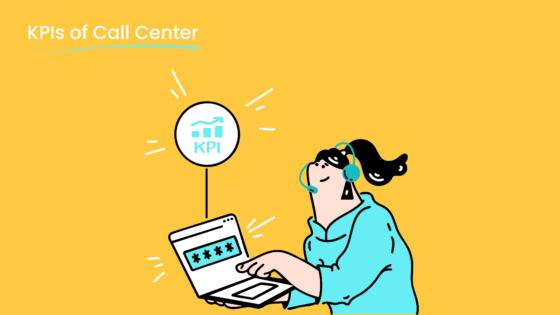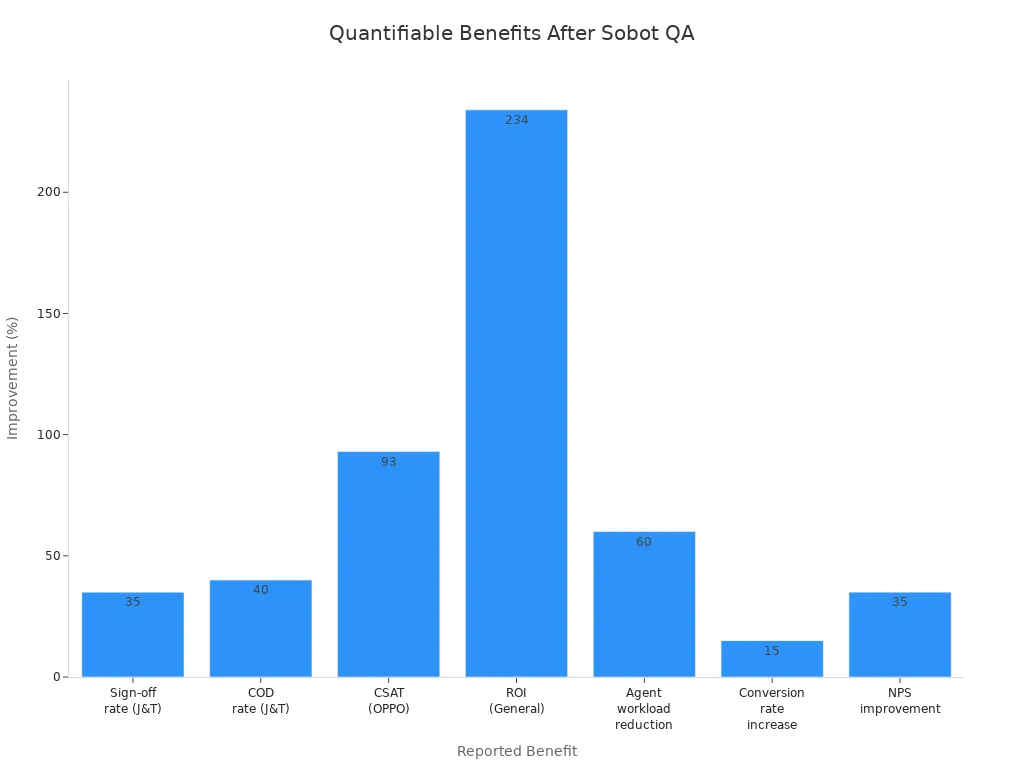Customer Service QA Trends Shaping Support Teams in 2025

Customer service QA trends will transform how you deliver customer experience in 2025. You face new demands as customers expect faster, more accurate service across every contact point. AI and automation set the pace for customer service trends, helping you boost efficiency and raise the bar for customer experience excellence. Leading companies, like those using Sobot AI and Sobot call center, already leverage innovation to unify service and contact channels. You see customers value seamless experience, with 86% willing to pay more for better service (source). Sobot empowers your customer support teams to deliver top-tier service and meet every contact need.
AI and Automation Trends

AI in Customer Service QA
You see AI and automation trends changing the landscape of customer service QA. Over the past three years, global AI adoption rates have soared, reaching between 72% and 78%. Most companies plan to increase AI investment, and 69% of C-suite leaders started investing in generative AI more than a year ago. The AI market is projected to grow from $86.9 billion in 2022 to $407 billion by 2025, with annual growth rates of 37.3% (source). These trends show that AI will continue to drive innovation in quality assurance and customer service operations.

Sobot’s AI-powered Voice/Call Center features help you enhance call center quality assurance by using intelligent IVR, real-time monitoring, and AI-powered voicebots. These tools detect subtle patterns in quality data, allowing you to identify root causes faster and shift from reactive to proactive quality management. You can scale expertise across your team, democratizing access to specialized knowledge and improving customer interaction outcomes. AI-driven agent tools, such as speech analytics and generative AI for agent assistance, boost agent performance and help you deliver a higher standard of service.
Organizations that align AI projects with business goals see measurable improvements in quality assurance, including faster resolution times, higher first contact resolution rates, and improved customer satisfaction scores.
Automation for Efficiency
Automation trends in customer service QA focus on streamlining performance and reducing complexity. Sobot’s automation features, like smart call routing and automated outbound tasks, lower average handle time and increase first contact resolution. Interactive voice response systems and centralized information access let your agents resolve customer inquiries quickly, improving both quality and performance.
- Automation directs calls to the right agent, reducing unnecessary transfers.
- Real-time collaboration tools help agents solve complex issues faster.
- Omnichannel support software allows agents to manage requests from multiple channels, lowering handle time and raising service quality.
You benefit from continuous feedback loops, which refine AI models and improve quality assurance processes over time. As AI and automation trends accelerate, you gain a competitive edge by delivering efficient, high-quality customer service interactions.
Omnichannel Customer Service QA
Unified Support Experience
You want your customers to feel valued every time they reach out. A unified support experience makes this possible. When you connect all your service channels, you remove data silos and give your team a complete view of each customer. This approach lets you deliver consistent, high-quality service and messaging across every interaction. Research shows that 87% of customers expect a seamless, personalized experience no matter which channel they use. When you meet this expectation, you build trust and increase satisfaction. Customers who enjoy a unified experience are more likely to return and recommend your brand. You also gain the ability to track customer behavior and preferences, which helps you improve your service quality and adapt to new trends.
To build an effective omnichannel customer service QA strategy, you should:
- Identify the channels your customers prefer.
- Invest in AI-driven platforms for seamless, proactive support.
- Train your team to handle complex issues and evolving expectations.
- Offer self-service options like chatbots and knowledge bases.
- Protect customer data privacy.
- Measure KPIs such as CSAT, NPS, and resolution time.
- Collect and analyze customer feedback.
- Track retention and loyalty metrics.
- Use automation for routine tasks.
- Consolidate data for a unified customer profile.
- Adapt your strategy based on performance data.
- Integrate all channels to overcome fragmented communication.
Sobot Omnichannel Solution
Sobot’s Omnichannel Solution helps you deliver seamless customer service QA by integrating all your communication channels into one platform. You can manage voice, chat, email, and social media from a single workspace. This unified approach improves operational efficiency and ensures every customer interaction meets your quality standards. Companies using Sobot report impressive results. For example, OPPO achieved a 93% customer satisfaction rate and a 57% increase in repurchase rate after adopting Sobot’s solution. Sobot also helped reduce agent workload by 60% and improved Net Promoter Score by 35%. The following table shows more quantifiable benefits:
| Company | Reported Benefit | Quantifiable Improvement |
|---|---|---|
| J&T Express | Increase in sign-off rate | +35% |
| J&T Express | Increase in COD collection rate | +40% |
| OPPO | Customer Satisfaction (CSAT) | 93% |
| SHEIN | Deployment of Copilot-powered agents | N/A |
| Weee! | Boost in Customer Experience (CX) | N/A |
| MICHAEL KORS | Enhanced communication across lifecycle | N/A |
| Transsion | Unified agent and data management | N/A |
| General | Return on Investment (ROI) | +234% |
| General | Agent workload reduction | 60% |
| General | Conversion rate increase | 15% |
| General | Net Promoter Score (NPS) improvement | 35% |
| General | Resolution time reduction | Under 1 minute |

You can see how Sobot’s omnichannel support transforms your customer service QA, driving higher satisfaction, loyalty, and quality in every interaction.
Data Privacy in Customer Service
Compliance Standards
You face a complex landscape of data privacy regulations in customer service. In 2025, stricter rules like GDPR, CCPA, and new laws in Brazil and India shape how you handle customer data. These regulations require you to process data lawfully, get clear customer consent, and give customers rights over their information. Failing to comply can lead to heavy penalties and damage your reputation.
You must also follow AI-specific rules, such as the EU AI Act, which demand transparency and ethical use of AI in customer interactions. This means you need to explain when AI is involved and how it makes decisions.
In industries like finance and healthcare, you must meet even higher standards. For example:
- Healthcare support teams must follow GMP, FDA 21 CFR Part 820, and ISO 13485 to ensure product safety and proper documentation.
- Finance teams work under SOX and PCI DSS, which focus on financial reporting and data security.
- Many organizations use ISO 27001 or NIST frameworks to manage information security.
You need to document every step, keep detailed records, and run regular audits. Using automated reporting tools helps you track compliance in real time and maintain high quality in your support operations. Sobot’s platform supports these needs by offering secure data handling and audit-ready reporting, making it easier for you to meet global standards.
Secure QA Practices
Protecting customer data is essential for maintaining trust and delivering high quality service. You should use strong passwords, limit access to sensitive information, and avoid sending private data through unsecured channels.
Key best practices include:
- Secure your network with VPNs and avoid public Wi-Fi.
- Use the Principle of Least Privilege to restrict data access.
- Replace real customer data in testing with synthetic or masked data.
- Require individual logins and multi-factor authentication for all users.
- Train your team to spot phishing and social engineering threats.
- Update your technology and security controls regularly.
- Prepare for breaches with clear recovery plans.
You share responsibility for data security across your team. Regular training and audits help everyone stay alert to risks. For example, the 2020 Twitter breach happened because staff had too much access. You can prevent similar incidents by enforcing strict access controls and using tools like Sobot’s unified workspace, which supports secure, role-based access and encrypted data transfer.
Tip: Always back up your data and use automated tools to monitor for unusual activity. This helps you catch problems early and maintain the quality of your customer service.
By following these practices, you protect your customers and ensure your QA processes meet the highest standards of quality and security.
Proactive Support and Predictive QA
Anticipating Issues
You can prevent many customer problems before they escalate by using proactive support strategies. When you analyze customer feedback and recognize patterns, you spot triggers that often lead to escalations. Open-ended questions in surveys help you gather deeper insights, revealing hidden issues early. Proactive communication, such as regular updates and transparent channels, builds trust and reduces frustration. You should train your QA teams with role-playing and simulation exercises to handle challenging situations more effectively.
Technology plays a key role in anticipating issues. Tools powered by ai and automation monitor real-time interactions and alert you to potential problems. For example, Sobot’s unified workspace lets you track customer sentiment and agent performance across all channels. This approach helps you identify pain points and take corrective action before customers consider leaving.
Here are some ways proactive support and predictive QA reduce churn and improve retention:
- Personalized engagement and outreach keep customers satisfied.
- Real-time support via chatbots or live agents resolves issues quickly.
- Monitoring feedback allows immediate corrective actions.
- Real-time agent coaching improves service quality.
- Analytics identify pain points for preemptive improvements.
- Proactive retention measures, like loyalty programs, reduce churn.
- AI-driven tools predict churn and guide agents in real time.
Companies that use proactive support see a 25% increase in customer satisfaction and a 30% decrease in support costs (Gartner). Predictive analytics can reduce churn rates by 10-15%, and a 10% drop in churn can boost customer lifetime value by up to 30% (Forrester).
Predictive Analytics
Predictive analytics transforms your customer service QA by enabling you to act before issues become problems. These tools use ai to monitor agent performance in real time, sending alerts when performance dips. You can coach agents immediately, ensuring high-quality interactions. Predictive models analyze large volumes of call and chat data, uncovering trends that highlight strengths and weaknesses in your team.
You benefit from continuous improvement because predictive models update with new data. This keeps your QA interventions accurate and relevant. Integrating data from multiple sources into a centralized system makes your analysis more precise and efficient. Sobot’s platform supports this by combining omnichannel data, sentiment analysis, and real-time alerts, so you always have a clear view of your team’s performance.
Here’s how predictive analytics tools contribute to better QA:
- Real-time monitoring of agent performance for immediate feedback.
- Automated analysis of interactions to spot trends and issues.
- Continuous refinement of predictive models for lasting accuracy.
- Centralized data integration for objective QA assessments.
- Real-time insights during calls to ensure quality standards.
- Sentiment analysis to predict customer emotions and enable empathetic responses.
- Integration with omnichannel platforms for consistent QA across all touchpoints.
Tip: Invest in quality data and scalable technology. Train your staff to use predictive analytics tools effectively. This empowers your team to deliver proactive, high-performance support.
By using ai and automation in your QA process, you improve operational efficiency, reduce costs, and deliver a better customer experience. Sobot’s solutions help you anticipate issues, act quickly, and maintain high standards of performance across every channel.
Personalization and Customer Service Trends
Hyper-Personalized QA
You see new trends in customer service shaping how you deliver support. Personalization stands out as a key driver for customer experience excellence. AI and machine learning now power hyper-personalized, predictive, and automated service experiences. These technologies help you anticipate customer needs and deliver solutions before issues arise.
- AI-powered chatbots provide 24/7 personalized support, giving customers quick and accurate answers.
- Predictive analytics identify at-risk customers, so you can reach out before problems escalate.
- Machine learning tailors every interaction, making each customer feel valued.
Personalization impacts important metrics. You notice higher customer satisfaction, better Net Promoter Scores (NPS), and faster response times. Companies using AI-powered CRM solutions report an average 25% increase in satisfaction scores. Personalized experiences also build emotional connections, leading to greater loyalty and higher retention rates. When you empower your team with real-time feedback and training, you ensure every customer receives high-quality, relevant service.
Industry leaders move beyond reactive support. They use hyper-personalization and predictive service as a competitive advantage, closing the feedback loop at scale and building trust with every interaction.
Sobot’s Customer-Centric Approach
Sobot helps you deliver these advanced customer service trends through a customer-centric approach. The omnichannel solution integrates all your customer contact channels—voice, chat, email, WhatsApp, and more—into one unified platform. This integration gives your team a complete view of each customer, making it easier to personalize every service experience.
Sobot’s AI-powered chatbots, enhanced by natural language processing and large language models, can work independently or assist your agents. This flexibility improves response quality and speed. The platform automates routine inquiries, freeing your support team to focus on complex service needs. You benefit from seamless communication across WhatsApp, Meta, Instagram, and Telegram, which increases efficiency and satisfaction.
Sobot also provides consulting and customer success services, helping you maximize the benefits of the platform. The user-friendly interface lowers the learning curve for your team, so you can deliver personalized service with less effort. By automating routine tasks and unifying data, Sobot enables you to focus on building strong customer relationships and driving loyalty.
With Sobot, you stay ahead of customer service trends, using personalization to boost satisfaction, retention, and revenue growth.
Feedback Loops and Training

Continuous Improvement
You drive quality by building strong feedback loops into your customer service QA process. These loops create a cycle where you collect, analyze, and act on customer feedback, employee insights, and process data. This approach helps you spot issues early and make quick improvements. For example, you can monitor QA processes in real time and set up alerts to catch problems before they affect satisfaction. Regular team meetings and automated feedback tools keep everyone informed and engaged.
To achieve continuous improvement, you should:
- Define clear customer service metrics like CSAT and review them often.
- Assign ownership of the QA process for accountability.
- Monitor all support channels to ensure consistent quality.
- Give agents regular feedback and coaching.
- Track progress after coaching to show improvement.
You also need to close the feedback loop by letting customers know how their input leads to change. This builds trust and shows your commitment to ongoing improvement. Sobot’s unified workspace supports this cycle by making it easy to gather and act on feedback from every channel. Automation and real-time monitoring help you detect and resolve issues faster, leading to higher satisfaction and better service.
Tip: Use surveys, polls, and in-app notifications to keep customers updated on changes made from their feedback. This transparency encourages more engagement and supports a culture of continuous improvement.
Cross-Department Training
You strengthen your support team by investing in cross-department training. This training helps employees understand different roles and builds empathy between departments. When your team learns together, they break down barriers and work as one unit. Employees gain new skills, which lets them handle a wider range of customer needs and maintain quality even during busy times or staff changes.
Cross-department training also creates a culture of learning and adaptability. You can use skill mapping and certification programs to make sure everyone understands quality standards. Simulation-based learning prepares your team for real-world scenarios, so they can deliver consistent service no matter the situation. Sobot’s platform supports flexible scheduling and knowledge sharing, making it easier to keep your team ready for any challenge.
A unified workforce with shared knowledge leads to better collaboration, higher satisfaction, and lasting improvement in customer service quality.
Industry-Specific QA Insights
Retail and Ecommerce
You face unique QA challenges in retail and ecommerce as digital transactions and customer expectations rise. Security testing now plays a critical role because cyberattacks target online stores more than ever. You need to run penetration and compliance tests to protect customer data and maintain trust. Performance testing must reflect real-world scenarios, especially during peak sales events, to ensure your systems handle high traffic and deliver a smooth experience for customers.
A successful QA strategy in this sector combines automation, AI, and continuous learning. You can use AI-driven automation to reduce manual QA work and focus on high-risk interactions. Sentiment analysis tools help you understand how customers feel about your service, while real-time agent support ensures consistent quality. Many companies invest in workforce management tools to optimize staffing and handle demand spikes.
Here is a summary of key challenges and solutions:
| QA Challenge | Solution |
|---|---|
| Handling peak traffic and frequent updates | Continuous automated testing frameworks |
| Skill gaps in AI and automation | Invest in training and certifications |
| Data privacy and security compliance | Robust test data management and compliance testing |
| Integration complexity | Modular, flexible testing architectures |
| Customer-centric QA | AI-driven platforms with real-time feedback |
You can see how Sobot’s omnichannel platform supports these needs by unifying customer data, automating workflows, and providing secure, scalable solutions for ecommerce businesses.
Financial Services
You operate in a highly regulated environment where QA must meet strict compliance standards. Financial services organizations use a tiered QA framework to ensure quality and regulatory adherence. At the operational level, you set clear quality standards and monitor daily metrics. Tactical QA focuses on continuous improvement, root cause analysis, and targeted training. Strategic QA aligns with your company’s vision, using advanced analytics and conversation intelligence to enhance compliance and customer satisfaction.
To address regulatory requirements, you should:
- Define quality standards that match regulations.
- Develop robust procedures and internal controls.
- Conduct regular audits and maintain accurate records.
- Train staff on compliance and security.
- Use advanced analytics for risk management and fraud detection.
- Encourage feedback from customers and employees.
You can leverage Sobot’s secure call center and ticketing system to document every customer interaction, automate compliance checks, and provide real-time guidance to agents. This approach helps you minimize legal risks and deliver a high-quality experience for your customers.
Tip: Regularly review your QA processes and update them based on new regulations and customer feedback.
Gaming and Entertainment
You need to deliver seamless support for players who expect fast, reliable service. Integrating QA early in development helps you catch issues before they affect customers. Agile methods and continuous integration let you adapt quickly and automate testing, reducing failures and downtime. User experience testing, including playtests and surveys, gives you direct feedback from players.
Data analytics tools help you monitor player behavior and engagement. You can use this information to target QA efforts and improve the gaming experience. Automation tools and AI technologies, such as reinforcement learning and predictive analytics, simulate player actions and forecast potential problems. This ensures your games remain stable and enjoyable for all customers.
Best practices for gaming QA include:
- Early QA integration using Agile methods.
- Automated testing and deployment with CI/CD.
- Regular playtests and surveys for player feedback.
- Data analytics to monitor engagement.
- Community involvement in testing phases.
Sobot’s omnichannel solution helps gaming companies manage player support across chat, voice, and social channels, ensuring every customer receives timely and effective help.
Note: Engaging your player community in QA not only improves your product but also builds loyalty among your customers.
You see customer service trends in 2025 focus on smarter contact, real-time feedback, and AI-driven automation. Support teams now use continuous training, emotional intelligence, and self-service to improve every contact. To stay ahead, you should:
- Audit your contact channels and data.
- Align AI and omnichannel strategies with business goals.
- Train agents for empathy and efficiency.
- Use Sobot’s unified contact platform for seamless integration.
Sobot helps you automate routine contact, boost response rates, and deliver quality at scale. Explore more at Sobot’s website or reach out for tailored support.
FAQ
What are the top customer service QA trends for 2025?
You will see customer service QA trends focus on AI, automation, and omnichannel solutions. Companies use predictive analytics and hyper-personalization to improve support. Sobot leads with advanced tools that help you deliver faster, more accurate service across every channel.
How does Sobot support omnichannel customer service QA?
Sobot’s omnichannel platform lets you manage voice, chat, email, and social media in one workspace. You can track every customer interaction, automate routine tasks, and improve quality. OPPO used Sobot to achieve a 93% CSAT and a 57% repurchase rate.
Why is automation important for customer service QA?
Automation reduces manual work and speeds up response times. You can use Sobot’s smart call routing and AI-powered chatbots to handle common questions. This lets your team focus on complex issues and improves your customer service QA trends.
How do AI and predictive analytics improve QA?
AI and predictive analytics help you spot problems before they grow. You can monitor agent performance in real time and get alerts for quality issues. Sobot’s platform uses these tools to help you maintain high standards and boost customer satisfaction.
What makes data privacy critical in customer service QA?
You must protect customer data to build trust and meet global laws like GDPR. Sobot ensures secure data handling with encrypted transfers and role-based access. This keeps your customer service QA trends compliant and your customers safe.
Tip: Always review your QA processes and update them as customer service QA trends evolve. Sobot’s resources can help you stay ahead.
See Also
How AI Agents Are Transforming Customer Support Services
Comprehensive Guide To Software For Call Center Quality
Revealing The Best Cloud Contact Centers For 2025